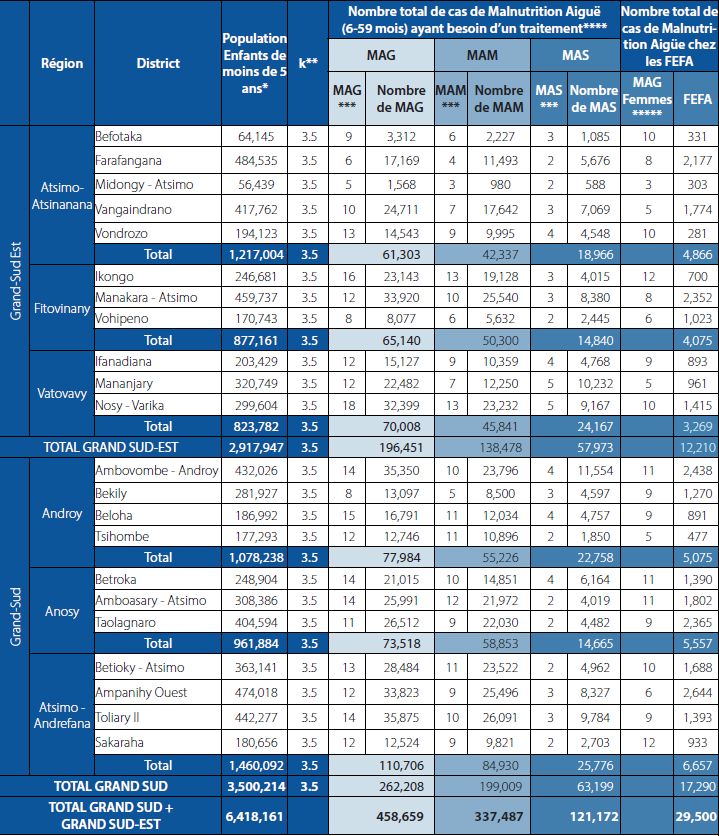22.08.2023
01.06.2023 > 30.04.2024
Map
Projected Map
Other Projections




Key
results
Population
estimates
Recommendations
& next steps
Acute
Malnutrition
Between June 2023 and April 2024, the acute malnutrition situation in Madagascar is likely to worsen significantly. Approximately 458,700 children under the age of five are likely to suffer acute malnutrition. Among them, over 121,000 children are expected to suffer from Severe Acute Malnutrition (SAM) and nearly 338,000 children are expected to experience Moderate Acute Malnutrition (MAM). In the Grand Sud Est region, an estimated 196,451 cases are projected, with 57,973 children in SAM and 138,478 children in MAM. Meanwhile, in Grand Sud, nearly 262,208 children are susceptible to acute malnutrition, including 63,199 children in SAM and 199,009 children in MAM. The districts likely to be most severely affected are Nosy Varika and Ikongo in Grand Sud Est, as well as Amboasary, Betroka, Betioky, and Beloha in Grand Sud.
By December, districts likely to be most affected are Nosy Varika and Ikongo in Grand Sud Est, and Amboasary, Betroka, Betioky, and Beloha in Grand Sud. The nutritional situation (June - September 2023) is projected to slightly improve before worsening during the lean season (January - April 2024). Notably, Nosy Varika and Ikongo are expected to be in IPC Phase 4, Critical, while Befotaka, Vangaindrano, Vondrozo, Manakara, Vohipeno, Ifanadiana, Mananjary, Ambovombe, Tsihombe, Beloha, Toliara II, Betioky Atsimo, Ampanihy Ouest, Amboasary, and Betroka are likely to be in IPC Phase 3, Serious.
Country Related Information
Contacts
- 01.09.2024 > 31.08.2025
Madagascar: Acute Food Insecurity Situation for September - December 2024 and Projections for January - April 2025 and May - August 2025 - 01.09.2024 > 31.08.2025
Madagascar: Acute Malnutrition Situation for September - December 2024 and Projections for January - April 2025 and May - August 2025 - 01.05.2024 > 30.04.2025
Madagascar: Acute Food Insecurity Situation for May - September 2024 and Projections for October - December 2024 and January - April 2025 - 01.10.2023 > 30.09.2024
Madagascar: Acute Malnutrition Situation for October 2023 - January 2024 and Projections for February - April 2024 and May - September 2024 - 01.10.2023 > 30.09.2024
Madagascar: Acute Food Insecurity Situation for October 2023 - January 2024 and Projections for February - April 2024 and May - September 2024 - 01.07.2023 > 30.04.2024
Madagascar: Acute Food Insecurity Situation for July - September 2023 and Projections for October - December 2023 and January - April 2024 - 01.11.2022 > 31.10.2023
Madagascar: Acute Food Insecurity Situation for November 2022 to March 2023 and Projections for April to July 2023 and August to October 2023 - 01.05.2022 > 30.04.2023
Madagascar: Acute Malnutrition Situation for May to September 2022 and Projection for October to December 2022 and January to April 2023 - 01.08.2022 > 31.03.2023
Madagascar: Acute Food Insecurity Situation for August to October 2022 and Projection for November 2022 to March 2023 - 30.05.2022 > 31.03.2023
Madagascar: Acute Food Insecurity Situation for April to August 2022 and Projections for September to November 2022 and December to March 2023 - 01.11.2021 > 31.08.2022
Madagascar: Acute Food Insecurity Situation November - December 2021 and Projections for January - April 2022 and May - August 2022 - 01.11.2021 > 31.08.2021
Madagascar: Acute Malnutrition Situation November - December 2021 and Projections for January - April 2022 and May - August 2022 - 01.04.2021 > 30.04.2022
Madagascar: Acute Food Insecurity April - September 2021 and Projection for October - December 2021 - 01.05.2021 > 30.04.2022
Madagascar: Acute Malnutrition Situation May - August 2021 and Projections for September - December 2021 and January - April 2022 - 01.10.2020 > 30.04.2021
Madagascar: Acute Food Insecurity for October - December 2020 and Projection for January - April 2021 - 01.10.2020 > 30.04.2021
Madagascar: Acute Malnutrition Situation October - December 2020 and Projection January - April 2021 - 01.02.2020 > 31.12.2020
Madagascar: Acute Malnutrition Situation February - April 2020 and Projections for May - August 2020 and September - December 2020 - 01.04.2020 > 31.07.2020
Madagascar: Acute Food Insecurity Projection Update April - July 2020 - 01.07.2019 > 30.06.2020
Madagascar: Acute Food Insecurity Situation July - October 2019 and Projections for November 2019 - March 2020 and April - June 2020 - 01.06.2019 > 31.12.2019
Madagascar: Acute Food Insecurity June - July 2019 and Projection for August - December 2019 - 01.08.2018 > 31.03.2019
Madagascar: Acute Food Insecurity Situation August - October 2018 and Projection for November 2018 – March 2019 - 01.03.2018 > 30.09.2018
Madagascar: Acute Food Insecurity Situation March-June 2018 and Projection for July-September 2018 - 01.08.2017 > 31.03.2018
Madagascar: Acute Food Insecurity Situation August-October 2017 and Projection for November 2017 - March 2018 - 01.03.2017 > 30.09.2017
Madagascar: Acute Food Insecurity Situation March - May 2017 and Projection for June - September 2017 - 01.03.2017 > 30.09.2017
Madagascar: Acute Malnutrition Situation March - May 2017 and Projection for June - September 2017 (Grand Sud) - 26.11.2016 > 31.03.2017
Madagascar: Acute Malnutrition Situation in Grand Sud for December 2016 and Projection for January-March 2017 - 01.10.2016 > 31.03.2017
Madagascar: Acute Food Insecurity Situation in Grand Sud for October 2016 - December 2016 and Projection for January - March 2017
- 04.07.2025 > 25.07.2025
Madagascar: Acute Food Insecurity and Malnutrition Analyses - 02.10.2024 > 05.10.2024
Madagascar: Acute Malnutrition Analysis - 15.06.2024 > 21.06.2024
Madagascar: Acute Food Insecurity Analysis - 09.12.2023 > 17.12.2023
Madagascar: Acute Food Insecurity and Acute Malnutrition Projection Update
Join our mailing list


